#1470s fashion
Explore tagged Tumblr posts
Text
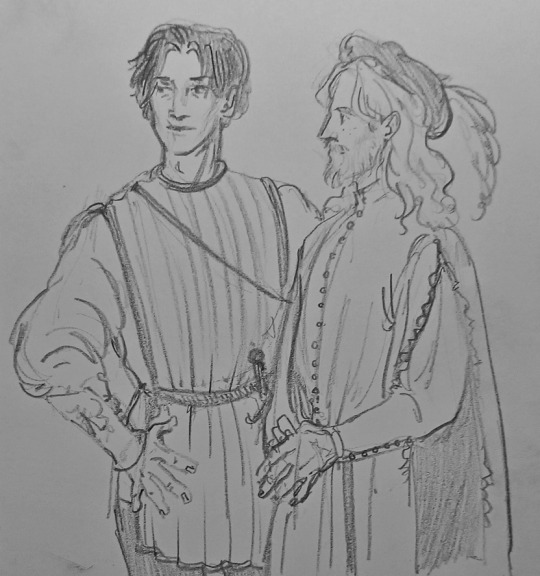
historically correct redesign for ezio and leonardo
390 notes
·
View notes
Text
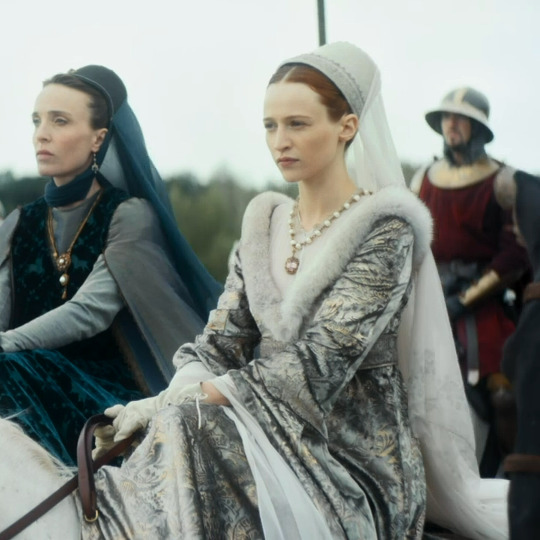
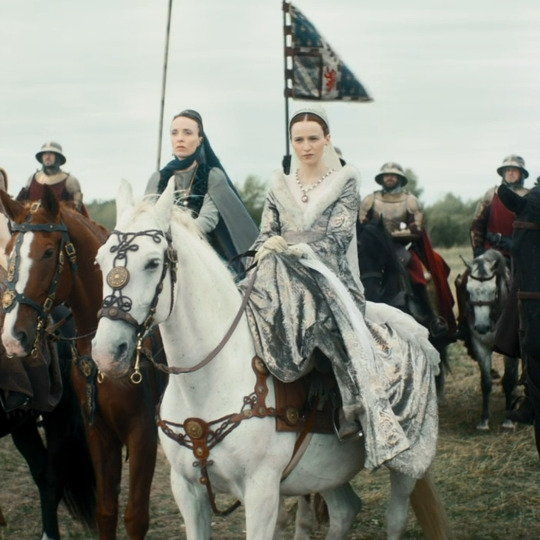
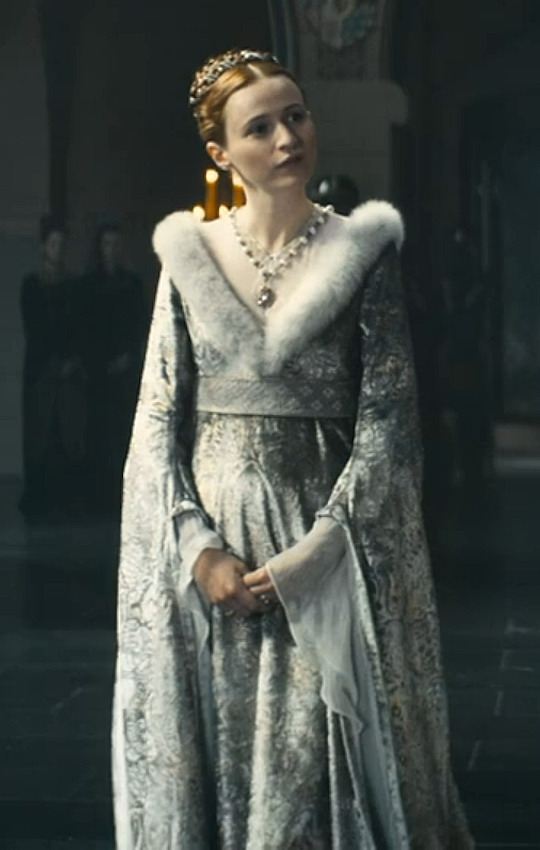
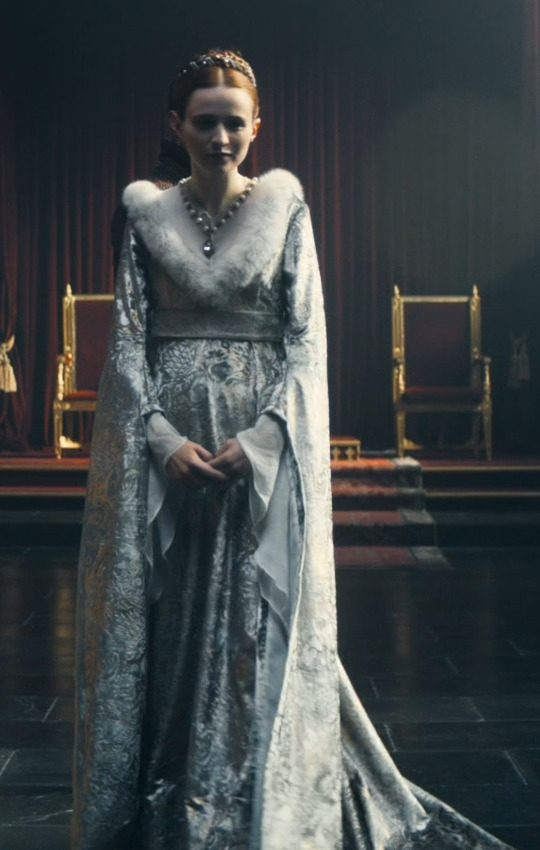
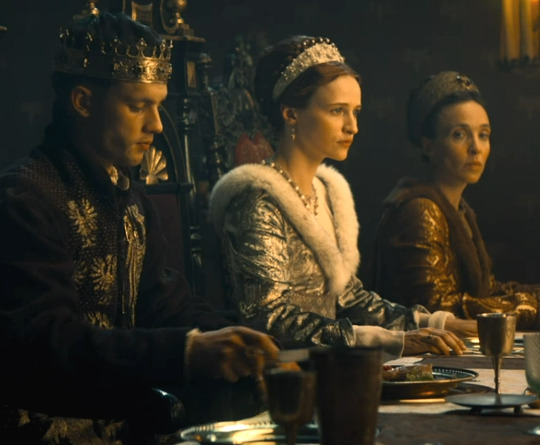
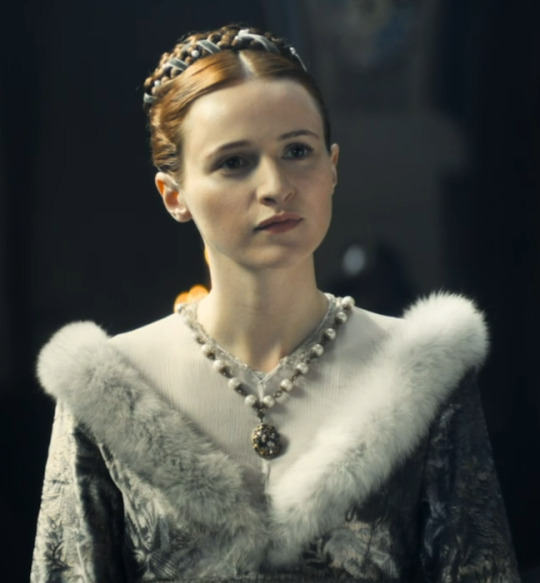
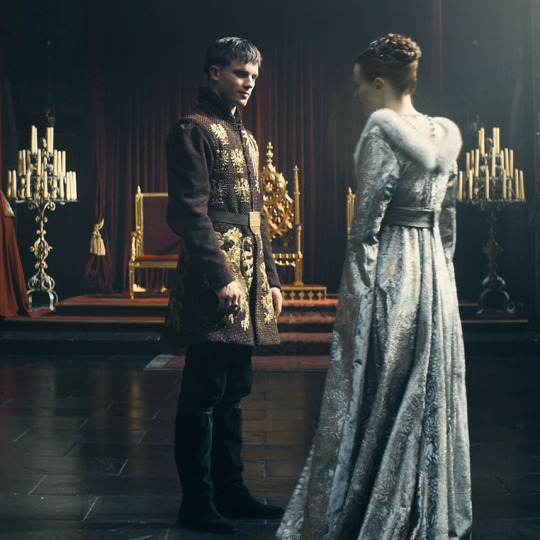
One Dress a Day Challenge
October: Silver Redux
Maximilian and Marie de Bourgogne (Maximilian: Das Spiel von Macht und Liebe) / Christa Théret as Marie of Burgundy
Marie wears this magnificent silver brocade gown when meeting Maximilian (whom she has already married by proxy) in person for the first time. As she tells him, Burgundy is the capital of cloth-making.
The historical event on which this is based took place in 1477. The costume designer for this series is Thomas Oláh.
We see Marie with three different variations of hairstyle and headdress with this gown (see below). I'm not sure about the period-authenticity of that pearl-studded tiara, but it is pretty. And at least she wears her hair up, unlike the heroines of many other historical productions.
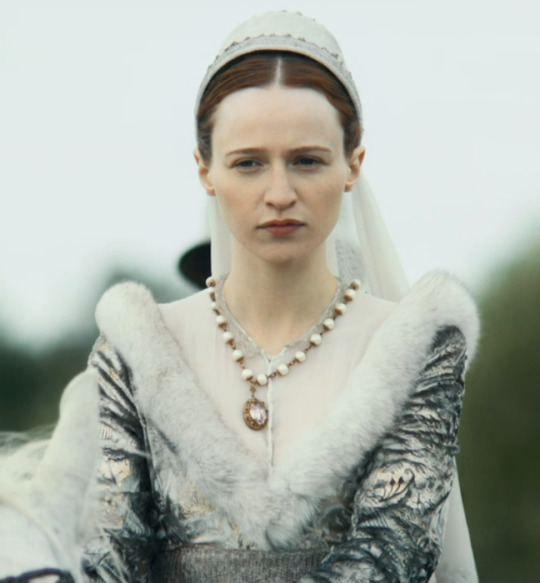
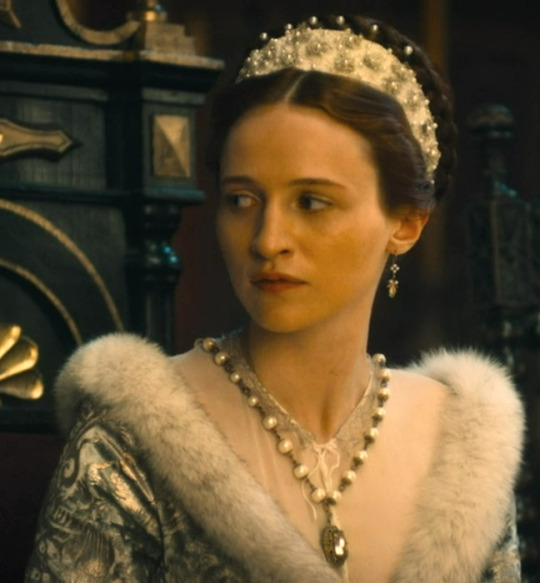
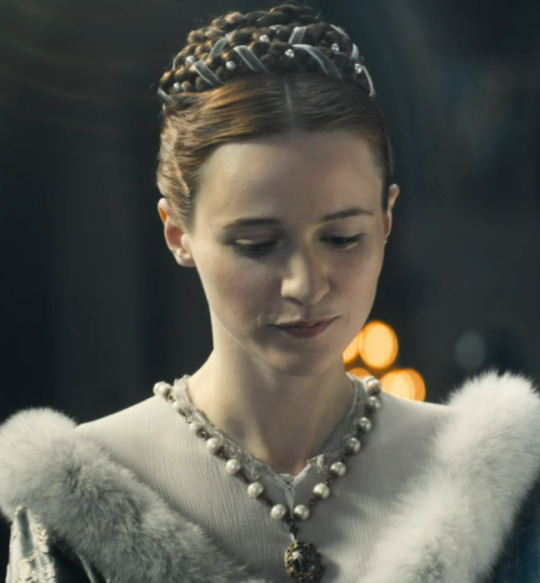
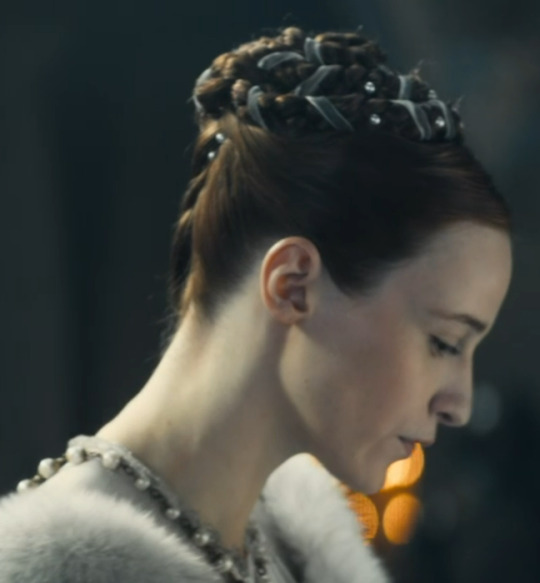
#maximilian and marie de bourgogne#Christa Théret#silver dresses#maximilian tv#silver dress#one dress a day challenge#one dress a week challenge#television costumes#tv costumes#period drama#medieval costumes#15th century costumes#Thomas Oláh#marie of burgundy#marie de bourgogne#1470s fashion#1470s style#silver redux
38 notes
·
View notes
Text

submitted by @shilohta 🩶🩷💛
#historical fashion poll submission#very historical historical fashion polls#historical fashion polls#fashion poll#historical dress#historical fashion#dress history#fashion history#fashion plate#15th century#15th century dress#15th century fashion#1400s#1400s dress#1400s fashion#1460s#1470s#1480s#skirt
285 notes
·
View notes
Text

Unknown artist (Southern Germany), A Bridal Couple, ca. 1470, oil on panel, 62.3 x 36.5 cm, The Cleveland Museum of Art
#I love all the details here#the plants the jewelry the colours the flowers in her hand and on his headband#the identical left sleeves#15th century#1470s#unknown artist#historical fashion#15th century fashion
72 notes
·
View notes
Text
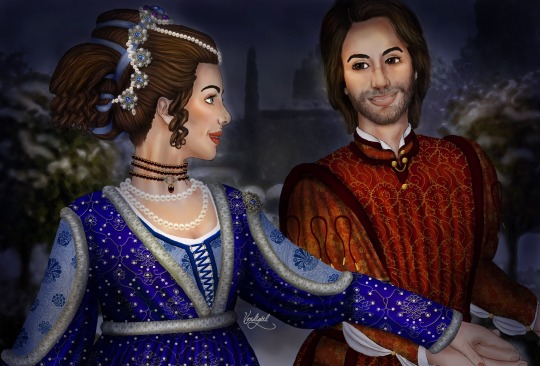
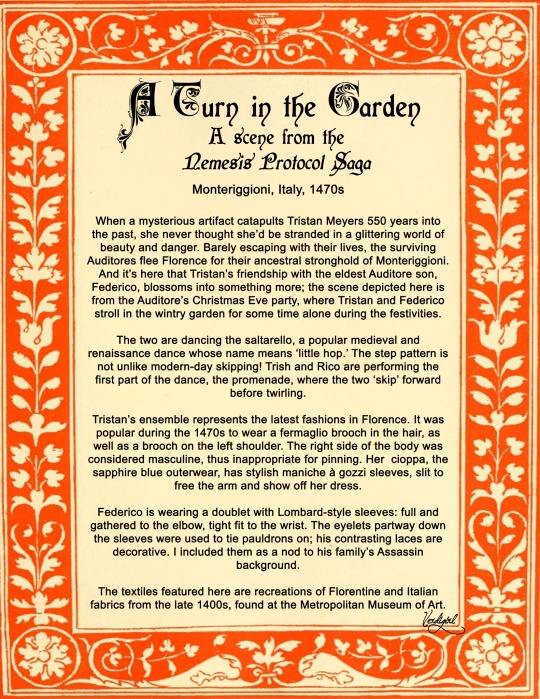
It was a pleasure to paint this art commission for the amazing @tkwritesdumbassassins ! Her Federico and Tristan is my Assassin Creed OTP; loved painting them. Based on 1470s Florentine fashion; all the fabrics are based on real textiles from the late 1400s, found at the Metropolitan Museum of Art in NYC.
Check out TK’s fic here! One of my favorites in the fandom. Thank you again for commissioning, TK! <3 (please click pictures for optimal quality!!)
#assassins creed#assassin's creed 2#assassin’s creed#federico auditore#assassin's creed fanfiction#justitia#Federico x OC#art commissions 2023#digital art#art commission#historical#historical fashion#italian renaissance#renaissance#1470s#15th century#nemesis protocol#seriously go read her fic it’s so good#my canon worldstate for ac2#the game will never be the same after reading it!#fic recs#musetta recs#my art#musetta draws
13 notes
·
View notes
Text
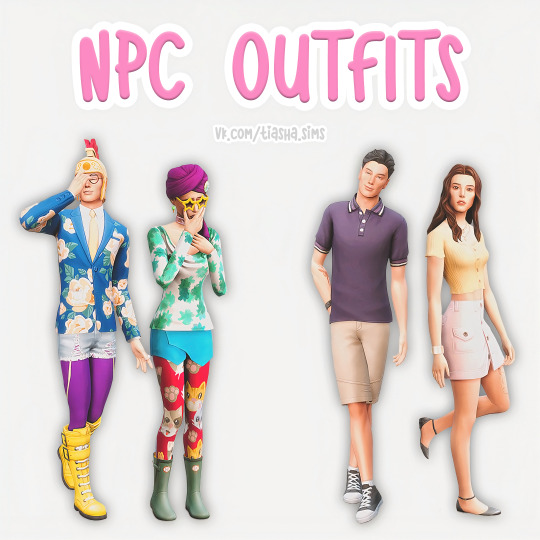
⠀
🎩 MCCC NPC OUTFITS | Умная генерация одежды 👠
Проект понравится тем, кого утомили нелепые 'модники', генерируемые игрой. Это файл настроек для Командного Центра, с прописанными нарядами для нпс.
The project will appeal to those who are tired of the silly 'fashionable' outfits generated by the game. It is a configuration file for the MC Command Center, with outfits specified for NPCs
⠀
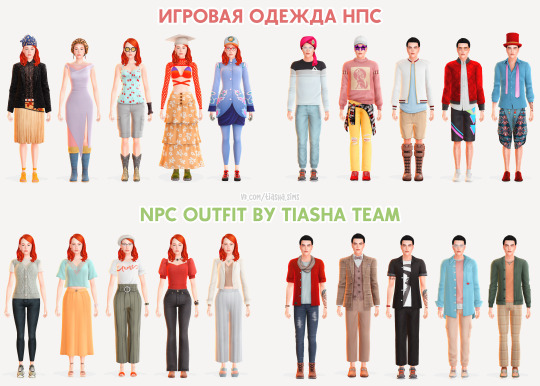
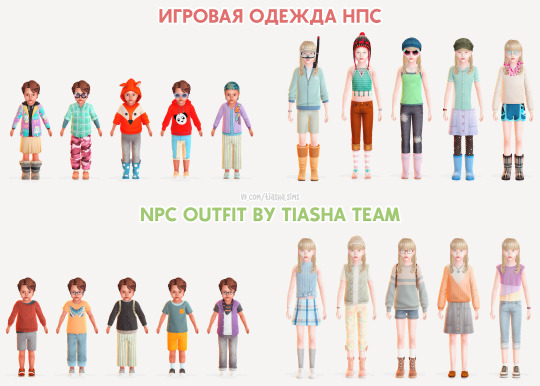
⠀ 🔎 ФУНКЦИОНАЛ | FUNCTIONAL
После установки мода, новые сгенерированные игрой персонажи будут одеваться в гармоничные наряды, а не рандомные несуразные вещи, как это было прежде. На уже существующих симов действие мода не распространяется.⠀After installing the mod, newly generated characters in the game will wear harmonious outfits instead of random, mismatched clothing as it was before. The mod does not apply to existing Sims.
Мы создали большое количество интересных образов для всех возрастов. Забудьте про отключение генерации нпс, ведь с этими настройками они будут выглядеть ничем не хуже ваших горожан!⠀We have created a large number of interesting characters for all ages. Forget about disabling NPC generation, with these settings they will look no worse than your citizens!
Дополнительно можно выставить настройку, позволяющую персонажам (в том числе играемым) при взрослении надевать наши сохраненные наряды, а не использовать рандомную одежду. Об этом ниже - в установке.⠀Additionally, you can set an option that allows characters (including playable ones) to wear our saved outfits when they grow up, instead of using random clothes. More on this is described below. ⠀ ⠀
😱 Более 10000 образов | More than 10000 outfits
Инфанты - 600 образов, по 50 уникальных нарядов в каждой категории у крохов и крошек.⠀Infants - 600 outfits, with 50 unique costumes in each category for boys and girls.
Тоддлеры - 1470 образов, по 105 уникальных нарядов в каждой категории у малышей и малышек.⠀Toddlers - 1470 outfits, with 105 unique costumes in each category for boys and girls
Дети - 2000 образов, по 125 уникальных нарядов в каждой категории у мальчиков и девочек.⠀Kids - 2000 outfits, with 125 unique costumes in each category for boys and girls.
Подростки-взрослые - 3680 образов, по 230 уникальных нарядов в каждой категории у парней и девушек.⠀Teens-Adults - 3680 outfits, with 230 unique costumes in each category for men and women.
Пожилые - 2800 образов, по 175 уникальных нарядов в каждой категории у дедушек и бабушек.⠀Elderly - 2800 outfits, with 175 unique costumes in each category for grandfathers and grandmothers. ⠀
⠀ 💿 УСТАНОВКА | INSTALL
❗ Необходимо полное собрание игры, а также мод MC Command Center. ⠀The full Sims 4 collection and MC Command Center mod are required.
Файл mc_dresser.cfg разместить в папку мода Командный центр.⠀Place the file "mc_dresser.cfg" in the mod folder "Command Center".
Чтобы наряды работали, корректируем параметры КЦ. В режиме жизни жмем на компьютер, выбираем МС Командный Центр, далее:⠀To make the outfits work, adjust the parameters of the MCCC. In the live mode, click on the computer, select "MC Command Center", then:
MC Гардероб > Настройки наряда > Используются только сохраненные наряды > Включена⠀MC Dresser > Only Use Saved Outfits > Enabled
MC Гардероб > Процент применения пользовательского скинтона > Ставим 0⠀MC Dresser > Percent Use Custom Skin Tone > 0
MC Население > Настройки населения > Проверка одежды неактивных симов > Включена⠀MC Population > Populating Settings... > Run Dresser > Enabled
MC Гардероб > Выбор возраста для действия модуля > Малыш, ребенок, подросток | Данный параметр включайте если хотите, чтобы при взрослении персонажи одевались в наши сохраненные наряды. Действует только на указанные возрастные категории. При желании вы можете выбрать и другие возраста.⠀MC Dresser > Ages To Run On Age-Up > toddler, child, teen | Enable this parameter if you want characters to wear our saved outfits when they age up. It only applies to specified age categories. If desired, you can also choose other age groups.
Если вы хотите переодеть уже существующего персонажа в сохраненный наряд, щелкните по симу > МС Командный Центр > MC Гардероб > Меню наряда > Случайный сохраненный наряд. Для каждой категории нужно будет повторить отдельно.⠀To dress up an existing character in a saved outfit, click on the Sim > MC Command Center > MC Dresser > Outfit Menu > Random Saved Outfit. You will need to repeat for each category separately. ⠀ ⠀
👒 Для улучшения внешнего вида НПС также рекомендую использовать | To improve the appearance of NPCs, it is also recommended to use
Tiasha - Names
Tiasha - No random hair
SimplyAnjuta - CAS Presets Selection
SimplyAnjuta - No random cas npc
⠀
━━━━ ✨ DOWNLOAD | VK ✨ ━━━━
⠀
Это не окончательная версия, наряды будут дополняться с выходом нового игрового контента.⠀This is not the final version, costumes will be updated with the release of new game content.
#tiasha_mod#ts4#simblr#mccc#command center#mod#mods#ts4 mod#ts4 mods#ts4 generation#ts4 clothes#ts4 npc#npc#mccc sims 4#симс 4#симблогер#симблог#симблер#симс 4 мод
417 notes
·
View notes
Note
Can you give an overview of your conworld and language for new people?
Absolutely! :D
The World
The setting I write in (hereafter "Boralverse") is an alternate history of Earth. The original difference from our own history (hereafter "IRL") is the existence of the island of Borland (Istr Boral) between Great Britain and Denmark, inspired by the IRL existence of Doggerland.

The human pre-classical history of Borland can be summarised as:
With sea level rise about 8k years ago, Borland was cut off from the continent and from Britain (this is when Doggerland was submerged IRL); some Stone Age people remain. They leave some monuments—burial mounds, the Çadrosc labyrinth—and were farmers, but they had no writing or ironworking.
The Celts arrive in Borland shortly before they settle Britain in the second millennium BCE, taking up iron tools and establishing many tribal groups. Due to some later migration from Britain to Borland, they speak a language (Borland Celtic) which is most closely related to Proto-Brythonic.
I assume that as far as possible the history of the rest of the world is indistinguishable from the IRL history up to this point. I continue to do so while the Romans invade and settle Borland shortly after Britain, despite conceding to credulity and allowing a few classical references:
...in Ptolemy's description of the Pritannoi we can understand he referred to the Insular Kelts of Ireland, Britain and Borland as a whole... ...contrasting Hadrian's policies in Britain and in Borland is vital for understanding their different fates in the post-Classical age...
where I admit that the Roman Empire having an entire additional province should probably have some observable effects.
Once the Western Roman Empire collapses, I start properly diverging Boralverse history from IRL history. This begins with a different pattern of Anglo-Saxon migration; the two petty kingdoms of Angland and Southbar arise in western Borland, while the settlement of England proceeds slightly slower than IRL.
Historical divergence spreads through western Europe over the next few centuries, and by 1000 CE things are beginning to go off the rails all across Eurasia and North Africa. I leave the history of the Americas the same until Old World contact (via Basque fishermen stumbling across Newfoundland in 1470 CE), and likewise with Australia.
The map below shows Europe in 1120, during the Second Tetrarchy Period. At this time, Europe was unusually centralised, with four great empires: the First Drengot Empire (red), the German Empire (brown), the Second Roman Empire (purple) and the Single Caliphate (green).
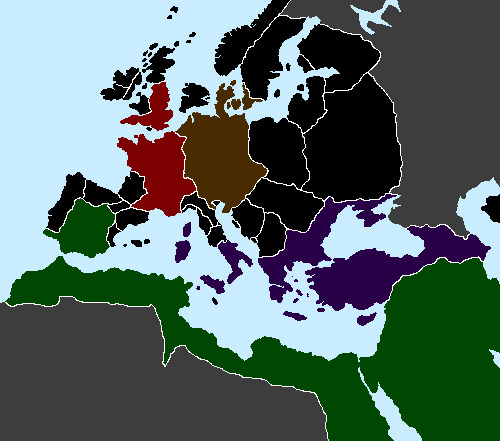
In the modern era, my hope is that the Boralverse world feels fractally uncanny; at every scale something is unexpectedly different, from political borders and languages to fashion and pop culture references.
For clarity, I employ an inconsistent Translation Convention when writing from a Boralverse perspective, mostly using IRL English but peppering in calques of Boralverse English jargon for flavour, such as threshold force "nuclear power" or jalick "garment socially equivalent to a tuxedo".
The Language
The original motivation for this alternate history setting is Borlish (Borallesc), the Romance language spoken on Borland.
It picked up a few Borland Celtic loanwords from the existing population at the time of the conquest (macquar ~ Welsh magu "raise, rear"; vrug ~ Welsh grug "heather"), but was much more influenced through the first millennium by Anglo-Saxon settlement and then Norse conquest during the Viking Age. The following is an example of late Old Borlish (ca. 1240):
…sovravnt il deft nostre saȝntaðesem eð atavalesem n iȝ atrevre golfhavn seȝ hamar dont y verb divin ismetre ac povre paian. peðiv soul ez font istovent por vn nov cliȝs d istroienz istablir… …uphold our most sacred and ancient duty to let Gulfhaven be the centre from which we will send the Word of God to pagan lands. We ask only for the necessary funds for a new teachinghouse…
The Modern Borlish language has undergone spelling standardisation (most recently deprecated some irregular spellings in 1870), and contains many more Latin and Greek loanwords, along with borrowings from languages across the world.
Y stal zajadau dy marcað nogtorn accis par lamp fumer eð y lun fragnt de mar receven cos equal party a domn pescour pevr jarras e fenogl gostant tan eð eç nobr robað n'ornament fluibond ant queldin raut frigsað ne papir cerous. The night market's various stalls lit by smoky lamps and the sea-shattered moon welcomed flocks of fishwives sampling paprika and fennel as well as notables in flowing finery carrying stir-fried suppers in wax papers.
In terms of sound changes and grammatical developments, the major points include:
Intervocalic lenition /p t k b d g/ > /v ð j ∅ ∅ ∅/: catēna > caðen "chain", dēbēre > deïr "must".
The use of ç (and c before e i y) for /ts/, and the use of g in coda to represent /j/. Along with some vowel shifts, this leads to things like cigl /tsajl/ "darling".
Total loss of final consonants in multisyllable words, including -s, which leads to:
Collapse of noun declension, including number; Borlish does not mark number on nouns, and if it wants to it uses demonstratives or simply relies of verb agreement: l'oc scuir pasc, l'ec scuir pascn "this boy eats, these boys eat".
60 notes
·
View notes
Text
Porter Gage x f!reader •°• Under management △SMUT△
Title: Under management
Rating: explicit, smut
Category: f/m
Fandom: Fallout 4
Relationship: reader x Gage, ss x gage, female overboss x Gage
Characters: Gage, reader
Tags/ triggers: Mild dubious consent if you squint, p in v, pwp, smut, vaginal fingering, no aftercare, OOC
Wordcount: 1470
a/n: idk how I feel about this one yet, but it's finished and that's something to be happy about.

When he had offered to be the man behind the overboss you didn't think he meant it quite as literally. He had been quite to the point in that initial conversation, most of it purged from your memory under the exhaustion and blood loss, but you remembered the ease in which he shot down your objections and took the back-seat, come to think of it, he did like the proverbial back-seat in most of your interactions...
Many a times he found himself behind you, hand anchored to the back of your neck as he took the time to tell you how good you take him whilst filling your cunt up to your skull, pressed against the old mattress as you cried out. It had barely been a few days when he first found himself pressed to the hilt, a quick motion that ended with you bent over the countertop, stools rolling on the floor from the jagged movement.
You could feel it as you walked through the parks, his eyes on you as he trailed behind. A quiet patience, control that seemed to snap once his eyes were the only ones on you, when he could maneuver you as he liked, where he dragged beyond the title of overboss even when still referring to you as it.
You should not like that fact, you rolled the thought over in your mind, cloudy intention in the sanctity of Fizztop Grille. Barely even a word exchanged until he once again maneuvered your body effortlessly onto the bed, pants already dragged to the floor and fingers pressed to your clothed core, biting into your lower lip as you looked up at his hulking form.
"Like that?" He asked, but didn't wait for a response, merely dragged your underwear to the side and pressed a finger into your tight heat.
You sucked in a breath at the feel of it, body tingling under the promise of the sweet release, yearning for the press of him once again. Your hands pressed to his shoulders in a keening display as your body opened up to him, a softness beneath the jagged movement as he took the time to pull at the threads of your body.
You mulled the emotion in your head as your head tipped back and sucked in another breath, repeated the mantra that it was just pleasure, it was just the raider way, thoughts that crumbled under the weight of his lips pressed to the side of your face, of the words layered upon your skin.
You were easy, you wagered. Something easy to manipulate and fashion into what he wanted, to artificially move into a position to take control of. The notion only made real in your mind by how you responded when his free hand moved up your body, slipping under your shirt and wrapping around your breast. You pushed into him as he played with the weight of it, whispering his name under the threat of your release building in your lower abdomen.
He was gracious enough to press his thumb to your clit as your hips jerked pathetically against his fingers. Your hands clenched against his shirt, biting into your lower lip hard enough to draw blood when you chanced a glance up at the man. His eye was focussed on where his fingers disappeared into your cunt.
"G-Gage.." You whimpered, that lead his gaze to your face. "I'm so... Close."
The smirk on his face was unmistaken as he shifted his weight a little to better regard you.
"Show me." He stated simply, doing more purposeful movements with his hand. " I want you to come on my fingers... boss."
By now he must've realized what the term does to you, had to have felt the way your cunt flutters against him when he uses it. He didn't say anything on the matter, but he purposefully used it in your most heightened state, pushed you into clenching around him.
You came with his name on your tongue, nails digging into your palm as you clenched them against his chest, chest pressing into his chest as the sensations ran through your body, for a moment consumed.
You bit into your lip when he removed his fingers from your cunt, small sound falling from your lips. He sat back, fingers pressing into your skin as he dragged your underwear down your legs. He watched on, attentive in the way his eye lingered on your body and settled between your legs. His fingers pressed into the soft flesh, keeping your thighs spread for him in his assessment. He glanced up at your face as his hand covered your sex, and he then slid a single digit through your slick folds.
"You are quite something..." His voice carried across the room, fingers wrapping over your hip. "Spread out like this, all for me." He didn't plan on wasting much more time, as he pulled his cock free with a few jagged motions to his pants and slapped it against your cunt, a chuckle reverberating at your sound of surprise. "Such a pretty little thing."
He shifted a little to get a better angle, lining up to your entrance and swiftly pressed onward, not enough to be able to thrust to the hilt at first, but he quickly worked his way inside, quick sharp motions that sucked the air from your lungs.
He quickly found a rhythm, much less pressed on you than where you connected, fingers digging into the flesh of your hips as he used the leverage to pull your body towards his as he thrusted, watching as his cock reappeared and then disappeared again inside your warm cunt.
"That's it..." He grunted through the motions. "So fucking tight... So good for me, boss."
You bit into your fist, eyes closed under the assault, sensation pricking at your skin as you were submerged under the feeling of his cock filling you up again and again, feeling your body rock against the mattress as he used your body for his own pleasure.
Lost in the pleasure, you didn't quite notice the shift until he pulled harshly at your wrist, dislodging the appendage from your lips and pressing it beside your head, fingers locking to keep it in place as he hovered over you.
"Let me hear it." He stated as he looked down at you, dragging your thigh over his hip as he took you. "Don't you dare fucking hide it from me."
You whimpered at the request, soft babbling under the sensation that turned louder until you called his name in a plea that you weren't sure exactly what you were asking for.
His hand left your wrist, sliding between your bodies and pressing flat against your clit, pressing a kiss against your exposed neck when your head moved to the side.
"I want you to come with me inside you." He spoke against your skin, the finger on your clit rapidly moving at the tail-end of the sentence. "I know you can do that for me."
You could feel your thighs quiver at the sensations that wrecked your body, your own fingers pressing into the skin of his back. You closed your eyes, with all the turmoil and confusion he caused, you rarely found the courage to not give into whatever he asked. You relented to the pressure in your lower abdomen, crying out his name as you gave in.
Your walls clenched around him, his hand digging into your hip in his effort to keep fucking into your tight cunt as you fell. You watched your expression shift, body shake, and he swore he could thank whatever god was out there to have you land in his lap so beautifully, so obediently.
"That's a good girl." He breathed, hips sloppily thrusting forward until he stilled, pressed deep into your cunt as he came, ropes of warm seed painting your insides as he grunted against your neck.
He was never one for intimacy or showing affection, but he couldn't help the way his eyes washed over your flushed face, but neither would you see it and ultimately, he pulled out without a word and flopped down beside your half dressed body, placing himself back in his pants before zipping up, like nothing had even happened. The only evidence the sweat on his skin and the liquid spilling from between your legs.
He was courteous in his own way you suppose, when he handed you a glass of water and the fact that he didn't kick you out of the bed, or leave himself until some time had passed after the deed, but perhaps it would've been better if he had, then you wouldn't have any hope to cling to that this could be more than what it evidently was to him.

You can support me on Ko-fi.
Masterlist
#satanwritesfanfiction#Porter Gage#Porter Gage Smut#Porter Gage x Reader#Gage#Gage Smut#Gage x Reader#Porter Gage x Reader Smut#Porter Gage PWP#Gage x Reader Smut#Smut
31 notes
·
View notes
Text

Chinese Salus Populi Romani (The Madonna Scroll) by Tang Yin (1470-1524)
In the context of disguised portraits, it is possible that this fashion also reached China with other Christian images, so the Madonna Scroll could in fact be a portrait of a member of the imperial family or an aristocrat disguised as a Madonna or Guanyin ...
Browse >>> Renaissance Poland-Lithuania - The Realm of Venus - Art in Poland (Artinpl) >>> for more …
Interesting and useful? Now you can buy me a coffee.
#artinpl#art#artwork#renaissance#painting#disguised#disguise#cryptoportrait#china#chinese#chinese art#scroll#guanyin#tang yin#italian#italian painting#byzantine#byzantine art#icon
2 notes
·
View notes
Text
my division of westerosi fashion n their inspos so that i don't forget 👍
overall inspired by the 1470s-1510s at most
the lands of always winter - siberian/alaskan inuit
the north - russian/ukranian/belarusian
iron islands - "viking" (norwegian, swedish, danish, but their fashions are more 1100s than 1500s)
the vale - switzerland/german
the riverlands - german/british
the westernlands - italian
king's landing - italian-british (heavy influence from surrounding areas)
the stormlands - italian-british-german (heavy influence due to the baratheons being a younger house)
the reach - portugal
dorne - moorish spain
in esos
the dothraki - ancient minoan-greek-crete (they're very nationalistic nomads, so their fashions have mostly remained the same)
bravos - turkey
mereen/astapor/qarth - byzantinian? (very traditional like the dothraki, but more ornate)
BONUS ROUND: NIGHT'S WATCH - most new brothers just dye their own clothes black. since most are northern men, their clothes aren't all that different. they also tend to borrow from the free folk's fashion for practicality during winter (the only difference being the color obviously)
and that's all I got ❤️
3 notes
·
View notes
Text
More mystery with portraits of Hasburgs
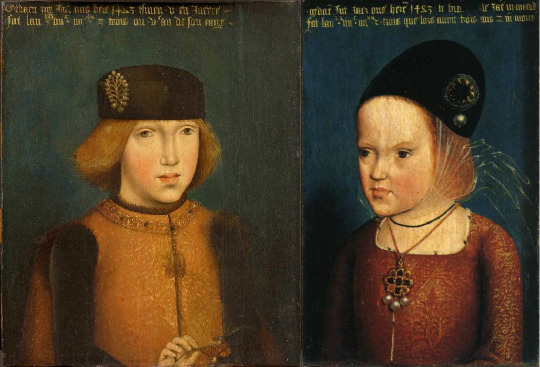
These two paintings are located in different museums, but are believed to be once a part. Currently they are labelled currently as Philip of Austria and Margaret of Austria, 1483, by Master of Legend of Magdalene.
And it's kind of a problem. Because at least the boy doesn't look like early work of this artist at all! Not even remotely close.
So other artists have been suggested instead, and for example the girl's has been most recently labelled as by Pierre Coustain.
Which doesn't make any sense either. Because while this was court artist in Burgundy, he specialized in making coat of arms and flags, sculptures etc. Like we can speculate on Pierre Coustain's involvement in these portraits(figures by Pieter van Coninxloo):
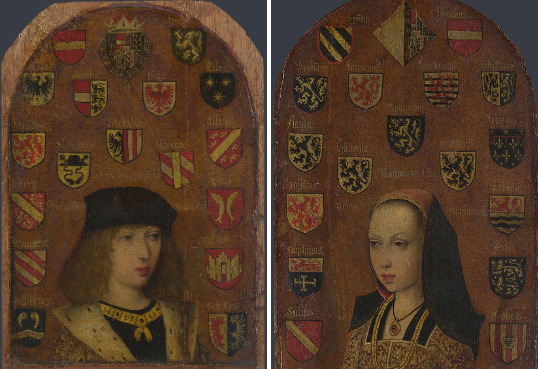
But only about the coats of arms. This guy wasn't portraitist.
...And you know me, I am nitpicker. I my motto is:
Never trust period label...because often times they are added centuries later.
So of course I checked the labels. On first glance, they seem as very genuine. This form of letters was around in 15 and 16th century.
...So I needed some help reading it, but luckily on wikipedia it was in description of paintings.
Girl's:

Gedaen Int Jaer ons here 1483 tsinen v en Jaerre/FAT LAN M.IIII.C.IIII.XX ET TROIS QUE LORS AUOIT TROIS ANS ET TROIS MOIS)
This was created in 1483 and she is 3 years and 3 months old.
(Very specific...oddly so.)

Gedaen Int Jaer ons here 1483 tsinen v en Jaerre / Fat Lan m. III c. IIII xx. z trois ou ve. an de son eage.
Once again it says year 1483, but that Philip is 3 or 5 years old.
Like how does nobody question this? You cannot be specific to month with girl, and not know how old the boy was!
Unless the label is not original at all! And likely not even done in 15th century. Because at those days, labels weren't really popular. They took off mainly in 16th century. And given the amount of mistakes I doubt Margaret nor Philip were even alive when this occured.
Because have they been, somebody would take greater care in getting it correct!
(And, If the text is from much later it is damn well-made.)
So if text is untrust-worthy, the dating of 1483 is also untrust-worthy, and then we cannot even be sure it is Philip or Margaret!

And though the boy doesn't fit Master of Legend's early work, he damn sure looks very alike to his late work! (1510-1527)
But then these kids cannot be royals from Netherlands. This is not its fashion from 16th century. We have portraits of Philip's kids raised in Netherlands, we know what they wore.
And while, yes the girl's hat looks bit like 1460-1470s male hats worn in netherlands, girls didn't wore this I checked. And given Netherlands were already back then northern capital of painters. It's very unlikely it wouldn't appear in art of that time from that country.
So possibly these are foreign royalty. But whom?
Well, artist started working around 1480/1490 and stopped about 1527. (Assuming we have correct artist.)
And the boy wears order of golden fleece around his neck. And clearly he is not adult. List of knights of Order of Golden fleece is on wikipedia and it includes when people got it and their birth year.
So finding people who got it before age of 15 in corrrect timeframe wasn't that hard.
Six candidates:
Philip of Austria (who it is currently identified as)
Henry VIII
Charles V
Ferdinand I, Holy Roman Emperor
Louis II, King of Bohemia and Hungary
Philibert of Chalon
But at age of 14 and 13, Henry VIII and Philibert are simply too old...to be depicted here. And Louis II's sister was older than he. And we know what Charles and his sisters raised in Netherlands wore.
Thus if not Philip and Margaret, the only other valiable option is Ferdinand and Catherine of Austria.
(if the list of candidates was complete...)
And it just so happens that if you put correct dimensions to these(in cm), and put them in order of birth, they don't look so weird...

Potentially this might have once been full set of siblings.
Done firstly around 1507(first four)
and rest after 1515, when Ferdinand became the member of the order.
...And if we compare what the girl wears with spanish fashion, then at least in examples from 1490s similiar hats were popular(not as much raised, but we always see them on adults. Maybe then the raise is not so high, and traluscent veils of this kind even much later(those are with cofia de tranzado)...this shape of neckline, also very popular in Spain at least around turn of the century.
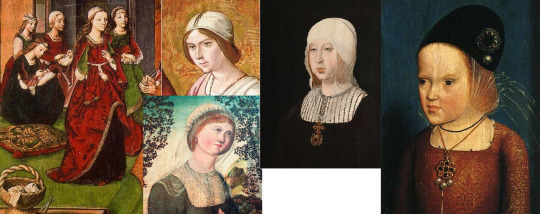
In my research into iberian fashion, i didn't go that much into fashion after 1505(not in debt) and it's not ideal that I point to examples about 20 years prior to when I think it might be.
But it is a possibility, and would explain the resemblence.
...
However then we have to assume 2 more possibilities.
A) the list of knights of order of fleece was not complete...and we're missing candidates...and then once again, where does the fashion point us?...Spain in case of girl...
B) But what if the boy and girl don't belong together?
What if they just had same background(popular in Burgundian/Netherlandish court from 1450? to about 1507)
and same dimensions(by chance, or they were later cut to make them same dimensions)?
(C)what if both options? L)ist wasn't complete and boy and girl don't belong together?
Well, the boys who got orders of golden fleeces as kids were usually royalty, with whom Hasburgs had friendly relationship.
Only other option already not covered, would be either Christian II of Denmark-but he was made member in 1519-so he is on the list, as adult...
or John, Prince of Asturias and Girona. He married Margaret of Austria, in 1497 and died that same year. And Joanna married Philip of Austria in 1496.
We know Margaret's portraits were created in early to mid 1490s, likely to be sent to Spain, and probably Philip's also.
But what if Spanish send reply? And Hasburgs send their own painter, to paint Spanish royal children? That would also explain resemblence to Joanna's children. Because boy would have to be her brother, and girl Joanna herself.
Again, the boy seems to be later work of the master, but it was a workshop. It is possible one of its member simply became more prominent later in workshop's lifetime and it happened to be him who was sent to paint the boy.
And i cannot get further than this. Dendrology would be helpful here.
However as these portraits have year upon them, the institutions who own them think they have the correct date already. We can only hope they decide to test it anyway.
14 notes
·
View notes
Text
OPERA COSTUMES NOW SUIT THE ROLE, NOT THE SINGER March 11, 1984, New York Times
Back in 1875 the famous diva Celestine Galli-Marie was about to create the title role in a new opera called ''Carmen.'' In preparation for the premiere, she ordered a suitable costume - one that was supposed to combine authentic Spanish flavor with a romantic sense of the picturesque in a manner befitting a star of the Paris Opera-Comique. Thus first- nighters witnessed Bizet's spitfire emerge from her shabby cigarette factory immaculately attired in a close-fitting frock of canary satin trimmed with black silk ball fringe, a black velvet bolero, and a wide- brimmed hat with ball fringe to match. ''Gypsy chic,'' one might have called it.
Two decades later, when Emma Calvé performed the same role at the Metropolitan, wearing a seedy shawl (her own, of course), the Diamond Horseshoe gasped in disbelief: they couldn't tell Carmen apart from the chorus. Even her tenor, Jean de Reszke, was stunned. Before singing the role of Don Jose, a sergeant of the Dragoons, he had purchased a gleaming pair of boots suitable for a general. Though they weren't aware of it at the time, Calve was helping to usher in a new age.
The concept of stage costume has changed considerably since opera's palmy days. During the 19th century it didn't matter whether the stars played courtiers or courtesans, barons or beggars, so long as they were arrayed in suitable finery. Elegance and opulence were the rule, and every singer of repute owned a personal stage wardrobe from crowns to shoes.
One can only imagine, therefore, the sort of stage picture that resulted when an international cast assembled to sing, say, ''Les Huguenots,'' ''I Puritani'' or ''Der Freisch"utz'' dressed in a blinding assortment of color schemes, styles and decorations. Certainly it was closer to a fancy-dress ball than an integrated production.
''Obviously this practice is discouraged nowadays,'' says Peter Hall, the most recent head of the Metropolitan Opera costume department. ''Productions should be absolutely complete. Moreover, period is often changed by directors wishing to break with tradition, and things become rather heated when somebody comes along dressed 200 years out of date.''
To the Victorians, richness of effect was paramount, hence old-style costume decoration was very fussy, with all manner of contrasting fabrics used in combination with yards of beads, ribbons, plumes, fake gems, and embroidery, not to mention the pleats and tucks that must have been an absolute terror to clean and press.
''Things are very much simpler today than they were at the turn of the century,'' says Mr. Hall. ''While some designers, such as Zeffirelli, look at old portraits and copy those styles exactly, another school will look at authentic styles and re-interpret them somewhat. Last comes the 'self-indulgent' school that says, 'I'm not going to listen to the music anyway - I'll just do what I think is nice. Obviously that is the wrong way to go about it, for in the end the music should be reflected in the look of sets and costumes. I don't think that you can do Monteverdi in space suits. It has been done, in fact, but the result was hardly successful.''
Space suits or not, stage costume has always tended somehow to mirror its own time. Whether Nellie Melba was singing Gilda, Violetta or the Countess in ''The Marriage of Figaro,'' her ''period'' gowns - which were supposed to represent roughly the years 1470, 1850 and 1785 respectively - emphasized the hour- glass figure dictated by fashion at the fin de si ecle. Photographs of Emma Eames as Tosca show her wearing a bosomy costume that is little more than a gored Edwardian morning dress with an appropriate picture hat. Further on in time, Maria Jeritza's Tosca boasted the svelte lines popular during the 1920's and 30's.
Make-up and coiffure also have a lot to do with period feeling, but most singers have tended to wear whatever is popular or flattering. For instance, dark eyelids, kewpie-doll lips and headbands worn low over the brow usually indicate performances of the post-World War I era, whether the role depicted is Tha"is, Lakme or the "Agyptische Helena, and everyone is familiar with the all-purpose hairdo that Dame Joan Sutherland lets down only for mad scenes.
Men have been just as fashion conscious. When large, waxed moustaches were the rage, Caruso, Florencio Constantino, Mattia Battistini and many others sported them even when portraying normally clean-shaven 18th-century characters in powdered wigs.
Renaissance and earlier historical styles gave Victorian and early 20th- century designers the chance to indulge in amazing flights of fancy shackled by considerations of modesty. A copy of Harper's Weekly from 1855 contains engravings of Giulia Grisi and Marietta Alboni as the protagonists of Rossini's ''Semiramide.'' As the exotic Queen of Babylon, Grisi wore a pointed bodice, short puff sleeves, multi-layered skirt over numerous petticoats, floor-length veil and Statue-of-Liberty coronet that were merely outlandish variations on the outfit worn by Queen Victoria to the opening of the Crystal Palace in 1851.
Alboni sang Arsace, a trouser role, in a short flounced skirt worn over voluminous pantaloons tucked into dainty suede-topped boots (to give the impression of pants while hiding her legs) . With her little painted moustache - lest anyone mistake her for a woman - she looked rather like Prince Albert in drag.
Biblical and ancient garb were generally treated more like upholstery than attire on the stage prior to 1920. Old production shots of ''A"ida'' show the singers draped like ottomans in layers of heavy, embroidered fabric that would have caused real-life Egyptians to drop from heat stroke. The traditional get-up for ''Samson and Delilah'' resembled the wares of a Levantine rug merchant.
''Once again, it is the music that governs the look,'' says Mr. Hall who remembered a production of ''Samson'' 20 years ago ''for which I had not paid as much attention to the score as I might have. We designed rough, tweedy things with heavy Sumerian fringes. Then, upon hearing the priestesses' music in Act I, I realized that it calls for silk and flowing drapery.''
Nowadays, some sopranos are sufficiently alluring to make sense of more revealing attire when necessary. Gwyneth Jones, for example, sang the ''Tannh"auser'' Venus at Bayreuth clad in little more than a fishnet. It is still a rare tenor, however, who can portray Radames, Samson or Siegfried bare-chested in the appropriate heroic - or sub-tropical - manner. Indeed, Peter Hoffmann, is the only exception that comes to mind. As Siegmund in the Bayreuth centennial production of the ''Ring,'' he managed to strip to the waist before his battle with Hunding in ''Die Walk"ure'' without looking foolish.
Simplification and a greater striving for comfort and economy have had a marked effect not only on contemporary costumes themselves, but on their accessories. Although Mr. Hall personally favors ''full period costumes using fabrics as close to the original as possible,'' synthetics and substitutes can frequently be more practical and less costly. ''I like wool to be wool and silk to be silk, but obviously things are so expensive nowadays that one can't always do it. Materials that were extravagant at $25 a yard 10 years ago are now $125. It is still more economical to buy leather in skins than the imitations, however. For one thing, imitations can't be cleaned, nor can they be shaped like the real article.''
Stage jewelry and armour tend to be much lighter today than formerly. Old opera crowns used to be made of gilded metal, but the Met usually uses gold kid on a felt or elastic base. ''In Italy,'' says Mr. Hall, ''armour is still often made by property departments using brass and tin. We're inclined to use felt or vacuform (a plastic) with a metalic coating. Jewelry has also been greatly simplified. The old practice was to set false gems and pearls in brass prongs, then to sew the entire setting to the fabric. ''Now we sew on the pearls and gems directly, and apply gold braid afterward to suggest the setting.''
Robert Tuggle, archivist of the the Met, who acts as curator of the historic collection along with restoration consultant Gail Frohlinger, recently commented that, ''Even though luxurious silks and handmade laces have yielded to less opulent fabrics and trimmings, the general level of costumes is higher today than it used to be. The greater attention now being paid by designers to the chorus and smaller roles has fostered productions for which the workmanship on minor costumes is on a par with that given the stars.''
Recalling the violent upheavals that formerly took place when divas and dressmakers disagreed, Mr. Hall observed that there are relatively few donnybrooks in the Met's costume department today because singers are more serious about their work than their forebears used to be. They still have their quirks, however. ''One singer will not permit wool or velvet to cover his chest - only hard satin, because he says his voice bounces off it.'' Another once insisted that his voice was going up inside his helmet and being trapped there - although it didn't cover his face at all. ''So we made small holes on each side - like a rain hat - and he was delighted.'' Some singers avoid certain colors, either due to vanity or superstition, while others take a liking to one color or even to a particular garment. Luciano Pavarotti, it seems, belongs to the second category. ''He has a pronounced tendency to wear his favorite black suede vest in everything,'' said Mr. Hall, ''and you may quote me on that because I'm sure he knows it himself.''
Whether he does know it or not, whether it stems from superstition or from a desire for personal comfort, we can regard the tenor's habit, perhaps, as a holdover from the palmy days, a slender link with those bursting steamer trunks of the opulent past. There have been many changes in the philosophy of the dressing room over the years, but it's nice to know that some customs remain immutable.
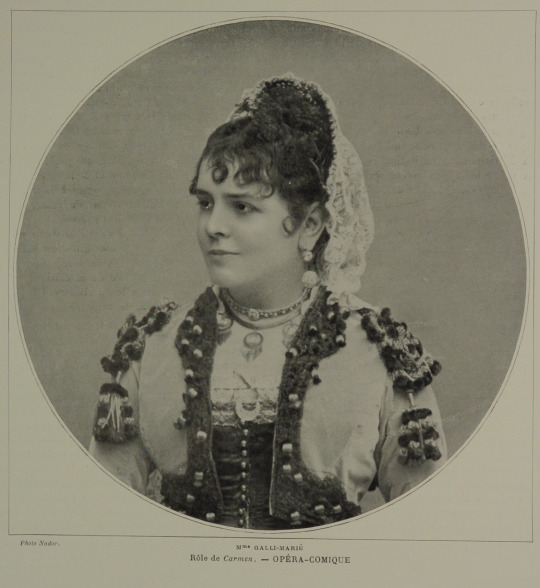
#classical music#opera#music history#bel canto#composer#classical composer#aria#classical studies#maestro#chest voice#Opera Costumes#Costumes#costume design#design#classical musician#classical musicians#classical history#history of music#historian of music#musician#musicians#diva#prima donna#Celestine Galli-Marie#Carmen#Emma Calvé#Tosca#The Metropolitan Opera#The Met#Metropolitan Opera
4 notes
·
View notes
Note
I thought I saw somewhere that you had a big pile of medieval clothing references? Am I crazy, is that a thing? Is it sharable? Otherwise, where do you search for references?
this one gets a little long, sorry about that anonnie
I did mention it at some point, yeah
most of my reference comes from my own personal collection of books that I've accumulated over the years, unfortunately many are not in English or I got them second hand and are difficult to find online
I don't have as much stuff regarding medieval fashion since most of the fashion that I am interested in starts around renaissance, so when I wanna look into older periods, it's fashion history books that are more general and provide a bit of an overview for the time periods
my two go-to books like that are The Costume History and then Fashion: The Definitive History of Costume and Style <-they're very general and barely touch on anything, much less proper structures, but they are a pretty good introduction to western fashion history
the book that I reach for regularly when I look into fashion for Monarchy Restoration is Dějiny Odívání: Renesance (Fashion History: Renaissance) - covers the fashions of mostly 15th and 16th century. this book is available only in Czech as far as I know and came out 23 years ago, also the information isn't particularly great (a trend I noticed with Czech authors, unfortunately.) the book is really well illustrated though which as someone who isn't particularly interested in recreating these styles for myself and only needs it for art is more than enough
I'm also fortunate enough to live in Europe so I get to visit castles and exhibitions regularly and I can gather my own reference by taking photos of the paintings, tapestries and frescos.
a great reference for actual medieval fashion are medieval illuminated manuscripts. I don't know where you're from, nor which area you want to look into, given how the fashion of the middle ages differs from country to country, so I'd definitely start by looking into books on medieval illustrations from the country you are interested in. I managed to snatch a really old copy of a book covering Slovak manuscripts and there's a book covering Czech ones (Krása českých iluminovaných rukopisů). many manuscripts have also been digitalized are available online
another thing you might consider is looking into illustrated books on medieval history. Jacques Le Goff has a sizeable collection and the prints that are available to me locally use many original medieval illustrations and paintings
old blogs dedicated to the topic are also amazing for this. given the state of tumblr and the internet as a whole, these are a lot harder to come by and many haven't been updated in years
I really wish I could tell you to scour the depths of google images and pinterest, but with the rise of artificial intelligence, people have started creating an unhealthy amount of fake history. it's honestly disheartening how many times I've caught myself looking at images and wondering if they are just passable fakes. this hurts even more when it comes to art used as reference, which is the main basis for medieval and early renaissance fashion, since the original garments are for the most part gone
to sum this up, I recommend looking into general fashion history books first. it's not great, but it's a start, especially if you only have a vague idea of what you want and aren't hellbent on finding accurate fashions to Venetian fashion of the 1470s, or something of that sort. a general look is a good starting point. from there, once you have pinpointed what you are after, look into books that might cover the topic. depending on the time period there might be detailed coverage in decent books, or you'll have to turn to other things such as books on the daily life in that time period (which have grown in popularity in the past couple of years) or book covering the art of the time period. those books might actually be better than fashion history books, since fashion history books prefer looking into the high society and not at commoners, who would have otherwise been depicted in paintings. they won't go into so much detail of the dress, obviously, but you'll get to see how the lower classes dressed as well. if you come across some proper vocabulary, it's worth doing a google search or pinterest search, though again, I have to warn you that people on the internet Like To Lie. A Lot. especially about history. while you are at it, you might also notice painter names popping up regularly, so look up their work as well. (personally been really into Cranach.) those paintings are great if you need only outer layers for art reference. in a similar manner, if you are looking into high society, it might be worth looking at the nobility and royalty of the time and their depictions.
last but certainly not least, if you have the chance to visit an exhibition, a castle, a cathedral, anything really that might deal with this stuff, go. you never know what you might come across. a lot of my favourite little reference photos were taken at castles that I visited with family and I didn't even expect to find anything at. it's very much about personal preference in fashion, too, so while you might see images in books, it might not be until you see a medieval painting of a saint that something about a dress just Clicks and you steal that style for your next OC. events organized by fashion history larpers are pretty good too if you don't mind talking to people, same for history themed events (NOT renaissance fairs. unless you run into people who actually know what they're doing) where people dress up for the occasion. not just some actors though, but actual proper historians who looked into their shit. I've met a couple amazing people and learnt a lot.
I don't know how valid this information is and I'm sure actual fashion historians are absolutely cringing at this, but as someone who mostly looks into fashion history for art reference, this is a method I found works for me. hope it helped at least a little!
#asks#fashion history#this got incredibly long oh my#I really wish I had more to share but its kinda hard to find stuff. plus Im more into local fashion history so I cant help with much#many things cross over among countries but it isnt perfect#its good to check youtube as well now that I think of it. but only proper groups or historians pls#besides Im not exactly keeping it a secret that I look into how fairytales depict this fashion as well. especially slavic movies#Im always wary of historical documentaries that has actors in costumes for a couple scenes theyre not always great#hollywood movies are just a massive No for the most part tho I like looking at them for Spice
10 notes
·
View notes
Text
judging the vibes of some typefaces




Futura: corporate - logo / cartoony
Gill sans: corporate but trying not to be - why so pointy ? i despise those s’s and the G makes me uncomfy. bad.
Didot: trying hard to be classy and succeeding - decorative / fashion magazine-y / so french
Hightower: laid-back, not trying hard to be classy, but still classy - info / subtle / storybook / petite ! / a series of unfortunate events
Hightower Research
Who: Tobias Frere-Jones When: 1990-94 Where: New York City What: A serif typeface
How: Influenced by Nicholas Jenson’s “old style” serif work from Venice in the 1470’s
font family includes italic (unlike Jenson's - as italic) but not bold (like Jenson's)
Adobe Fonts: "Hightower’s wide proportions and deep color were calibrated for small text sizes. Its organic forms and details also work well in headlines, adding complexity and subtlety.”
2 notes
·
View notes
Text
Updated list of the Big Lots stores that are closing down by state
Alabama:
1327 S Brundidge St., Troy
Arizona:
1416 E Route 66, Flagstaff17510 N 75th Ave, Glendale
3630 W. Baseline Rd., Laveen
2840 E Main St., Ste 109, Mesa
6839 E Main St., Mesa
24760 N Lake Pleasant Pkwy, Peoria
2020 N 75th Ave, Ste 40, Phoenix
230 E. Bell Rd., Phoenix
4727 East Bell Rd., Phoenix
2330 W Bethany Home Rd., Phoenix
4835 E Ray Rd., Phoenix
1260 Gail Gardner Way, Prescott
10220 N 90th St., Scottsdale
940 E Baseline Rd., Tempe
7025 E Tanque Verde Rd., Tucson
4525 N Oracle Rd., Tucson
3900 W Ina Rd., Tucson
2520 S Harrison Rd., Tucson
Arkansas:
2999 N College Ave, Fayetteville
California:
1670 W Katella Ave., Anaheim
6336 E Santa Ana Canyon Rd., Anaheim
2240 El Camino Real, Atascadero
1085 Bellevue Rd., Atwater
1211 Olive Dr., Bakersfield
2621 Fashion Pl., Bakersfield
1482 E 2nd St., Beaumont
353 Carmen Dr., Camarillo
19331 Soledad Canyon Rd., Canyon Country
1611 E Hatch Rd., Ste A Ceres
1927 E 20th St., Chico
12550 Central Ave., Chino
2060 Monument Blvd, Concord
740 N Main St., Corona
5587 Sepulveda Blvd., Culver City
912 County Line Rd., Delano
1085 E Main St., El Cajon
8539 Elk Grove Blvd., Elk Grove
1500 Oliver Rd., Fairfield
9500 Greenback Ln., Ste 22, Folsom
17575 Foothill Blvd., Fontana
1986 Freedom Blvd., Freedom
3520 W. Shaw Ave, Fresno
4895 E Kings Canyon Rd., Fresno
7370 N Blackstone Ave., Fresno
2900 W Rosecrans Ave., Gardena
360 E 10th St., Gilroy
1551 Sycamore Ave., Hercules
42225 Jackson St., Ste B, Indio
3003 W Manchester Blvd., Inglewood
1020 W Imperial Hwy, La Habra
6145 Lake Murray Blvd., La Mesa
4484 Las Positas Road, Livermore
380 S Cherokee Ln., Lodi
1009 N H St, Ste M, Lompoc
2238 N Bellflower Blvd., Long Beach
951 W Pacheco Blvd., Los Banos
1321 West Yosemite Ave., Manteca
665 Fairfield Dr., Merced
111 Ranch Dr., Milpitas
27142 La Paz Rd., Mission Viejo
3900 Sisk Road, Modesto
3615 Elkhorn Blvd., North Highlands
1702 Oceanside Blvd., Oceanside
4430 Ontario Mills Pkwy, Ontario
1875 Oro Dam Blvd E., Oroville
6646 Clark Rd., Paradise
47 Fair Ln., Placerville
30501 Avenida De Las Flores, Rancho Santa Margarita
810 Tri City Ctr., Redlands
2620 Canyon Springs Parkway, Riverside
565 Rohnert Park Expressway, Rohnert Park
6630 Valley Hi Dr., Sacramento
8700 La Riviera Dr., Sacramento
370 Northridge Mall, Salinas
499 W Orange Show Rd., San Bernardino
3735 El Camino Real, Santa Clara
1417 S Broadway, Santa Maria
568 W Main St., Ste B, Santa Paula
2055 Mendocino Ave, Santa Rosa
1189 Simi Town Center Way, Simi Valley
633 Sweetwater Rd., Spring Valley
2720 Country Club Blvd, Stockton
27411 Ynez Rd., Temecula
955 Sepulveda Blvd, Torrance
2681 N Tracy Blvd, Tracy
1840 Countryside Dr., Turlock
225 Orchard Plz, Ukiah
818 Alamo Dr., Vacaville
14790 La Paz Dr., Victorville
2525 S Mooney Blvd., Visalia
13241 Whittier Blvd., Whittier
52 W Court St., Woodland
1320 Franklin Road, Yuba City
56865 29 Palms Hwy, Yucca Valley
Colorado:
6626 South Parker Road, Aurora
1990 S Academy Blvd, Colorado Springs
2975 New Center Point, Colorado Springs
5085 N Academy Blvd, Colorado Springs
2401 N Ave, Ste 19b, Grand Junction
2628 11th Ave, Greeley
8100 W Crestline Ave., Unit B5, Littleton
2151 Main St., Longmont
Connecticut:
1470 Pleasant Valley Road, Manchester
56 Turnpike Square., Milford
3105 Berlin Tpke., Newington
42 Town St., Ste 1200, Norwich
1931 E Main St., Torrington
650 Wolcott St., Waterbury
40 Boston Post Rd., Waterford
560 Windsor Ave., Windsor
Florida:
21697 State Rd., 7, Boca Raton
25191 Chamber Of Commerce Dr., Bonita Springs
901 N Congress Ave., Boynton Beach
7381 52nd Pl E, Bradenton
328 E Sugarland Hwy, Clewiston
4847 Coconut Creek Pkwy, Coconut Creek
2400 W International Speedway, Daytona Beach
34940 Emerald Coast Pkwy, Destin
15271 Mcgregor Blvd., Fort Myers
1761 E Hallandale Beach Blvd., Hallandale
3921 Oakwood Blvd., Hollywood
8265 W Flagler St., Miami
5580 Nw 167th St., Miami Lakes
2882 Tamiami Trl E, Naples
700 Blanding Blvd, Ste 1, Orange Park
11230 S Orange Blossom Trl, Orlando
11672 E Colonial Dr., Orlando
1801 S Semoran Blvd., Orlando
7067 W Broward Blvd., Ste B, Plantation
1440 Ne 23rd St., Pompano Beach
11854 Us Highway 19, Port Richey
511 N State Rd. 7, Royal Palm Beach
3750 Bee Ridge Rd., Sarasota
2236 Se Federal Hwy, Stuart
12601 Citrus Plaza Dr., Tampa
41306 Us Hwy 19 N, Tarpon Springs
Georgia:
2738 Candler Rd., Decatur
375 Pavilion Pkwy, Fayetteville
610 Holcomb Bridge Rd., Ste 300, Roswell
13051 Abercorn St., Savannah
31 Hwy 138 W, Ste 150, Stockbridge
5370 Stone Mountain Hwy, Ste 300, Stone Mountain
687 Main St., Thomson
263 S Liberty St., Waynesboro
Illinois:
8148 S Cicero Ave., Burbank
1699 River Oaks Dr., Calumet City
1139 W Broadway, Centralia
1608 N Larkin Ave., Crest Hill
204 S. Randall Rd., Elgin
10850 Lincoln Trl, Fairview Heights
340 Summit Dr., Lockport
7233 W Dempster St., Niles
17w714 W 22nd St., Oakbrook Terrace
Indiana:
138 W Hively Ave., Elkhart
3958 Illinois Rd., Fort Wayne
8401 Michigan Rd., Indianapolis
2136 E Markland Ave., Kokomo
2806 Frontage Rd., Warsaw
Kansas:
7533 State Ave., Kansas City
2450 South 9th St., Salina
Kentucky:
1321 2nd St., Henderson
1980 Pavilion Way, Lexington
4025 Poplar Level Rd., Unit 102, Louisville
Louisiana:
3161 E Texas St., Bossier City
2354 S Range Ave., Denham Springs
3557 Ambassador Caffery Pkwy, Lafayette
339 South Dr., Ste D, Natchitoches
Maine:
1100 Brighton Ave., Portland
Maryland:
4420 Mitchelville Rd., Bowie
6623 Governor Ritchie Hwy, Glen Burnie
3331 Corridor Marketplace, Laurel
21800 N Shangri La Dr., Unit 20, Lexington Park
11989 Reisterstown Rd #a, Ste A, Reisterstown
Massachusetts:
41 Pond St., Ashland
400 Main St., Dennis Port
178 N King St., Northampton
179 Highland Ave., Seekonk
1150a Union Street Ext., West Springfield
Michigan:
750 Perry Ave., Big Rapids
373 N Willowbrook Rd., Coldwater
2353 N Park Dr., Holland
3669 E. Grand River Ave., Howell
4254 28th St. Se, Kentwood
5625 W Saginaw Hwy, Unit 1, Lansing
32399 John R Rd., Madison Heights
2020 Grand River Ave., Okemos
1401 Spring St., Petoskey
6207 S Westnedge Ave., Portage
2850 Washtenaw Ave., Ypsilanti
Minnesota:
2614 Bridge Ave., Albert Lea
Missouri:
4201 S Noland Rd., Independence
3225 Missouri Blvd., Jefferson City
13637 Washington St., Kansas City
1417 N Belt Hwy, Saint Joseph
4433 Lemay Ferry Rd., Saint Louis
4930 Christy Blvd., Ste 2, Saint Louis
Montana:
1200 10th Avenue South, Great Falls
2930 Prospect Ave., Helena
New Hampshire:
216 Washington St., Claremont
Nevada:
1601 W Craig Rd., N Las Vegas
New Jersey:
471 Green St., Woodbridge
New York:
2276 Delaware Ave., Buffalo
698 S Ogden St., Buffalo
4406 State Route 5 & 20, Ste 129, Canandaigua
260 Voice Rd., Carle Place
231 Centereach Mall, Centereach
2309 N Triphammer Rd., Ithaca
4645 Commercial Dr., New Hartford
316 Cornelia St., Plattsburgh
43 Burnett Blvd., Poughkeepsie
751 Upper Glen St., Ste 2, Queensbury
North Carolina:
8215 University City Blvd., Ste E, Charlotte
9535 S Blvd., Ste C, Charlotte
2000 Avondale Dr., Ste E, Durham
3420 Southwest Durham Dr., Durham
822 E Main St., Jefferson
1515 Garner Station Blvd., Raleigh
6540 Glenwood Ave., Raleigh
Ohio:
11372 Princeton Pike, Cincinnati
9690 Colerain Ave., Cincinnati
359 Miamisburg Centerville Rd., Dayton
1520 N Clinton St., Defiance
1170 Indiana Ave., Saint Marys
410 E Perkins Ave., Sandusky
4925 Jackman Rd., Ste 15, Toledo
7779 Tylersville Rd., West Chester
Oregon:
2000 14th Ave. Se, Albany
18565 Sw Tualatin Valley Hwy, Beaverton
1960 Echo Hollow Rd., Eugene
304 Ne Agness Ave., Grants Pass
2083 Ne Burnside Rd., Gresham
2121 Newmark St., North Bend
16074 Se Mcloughlin Blvd., Ste 8, Portland
2025 Lancaster Dr. Ne, Salem
Pennsylvania:
713 E Baltimore Ave., Clifton Heights
2820 Gracy Center Way, Coraopolis
201 West Lincoln Hwy, Exton
345 Scarlet Rd., Ste 22, Kennett Square
199 Franklin Mills Blvd., Philadelphia
2980 Whiteford Rd., York
South Carolina:
1016 Pine Log Rd., Aiken
1841 J A Cochran Byp., Ste A, Chester
1937 Wilson Rd., Newberry
South Dakota:
1617 Eglin St., Rapid City
Tennessee:
209 S Royal Oaks Blvd., Ste 206, Franklin
2301 Gallatin Pike N, Madison
1410 S 1st St., Union City
Utah:
702 E State Rd., American Fork
1030 North Main Street, Layton
1617 North Main Street, Logan
5516 South 900 East, Murray
Vermont:
1400 Us Route 302, Berlin
303 Us Route 4 E., Rutland
Virginia:
590 Branchlands Blvd., Charlottesville
736 Warrenton Rd, Unit 102, Fredericksburg
2110 Wards Rd., Lynchburg
7743 Sudley Rd., Manassas,
5900 E. Virginia Beach Blvd, Norfolk
8533 Midlothian Tpke., North Chesterfield
1650 General Booth Blvd, Ste 200, Virginia Beach
14603 Telegraph Rd., Woodbridge
Washington:
1650 Birchwood Ave., Bellingham
14907 4th Ave Sw., Burien
17307 Se 272nd St., Covington
6727 Evergreen Way, Everett
1301 W Meeker St., Kent
1515 Marvin Rd Ne., Lacey
5401 100th St Sw, Ste 102, Lakewood
5710 196th St Sw, Lynnwood
2815 Capital Mall Drive Sw, Olympia
1940 E. 1st St., Port Angeles
3399 Bethel Rd. Se, Port Orchard
120 31st Ave Se, Puyallup
14215 Se Petrovitsky Rd., Renton
1743 George Washington Way, Richland
9612 N Newport Highway, Spokane
1414 72nd St., Tacoma
2100b Se 164th Ave., Ste E, Vancouver
151 Easy Way, Wenatchee
Wisconsin:
616 W Johnson St., Fond Du Lac
3960 Mormon Coulee Rd., La Crosse
N78w14511 Appleton Ave., Menomonee Falls
5415 Washington Ave., Mount Pleasant
699 S Green Bay Rd., Neenah
3426 Kohler Memorial Dr., Sheboygan
1690 S Main St., West Bend
Wyoming:
3501 E Lincolnway, Cheyenne
0 notes
Text
A Reenactment
We had a talk with Patrick 3000, an Irish artist living aboard in Berlin. We had a group project to complete at the end of the talk, picking one of the famous historic paintings to reinterpret in our own style. From the selection we choose a piece by Hugo Van der Goes.
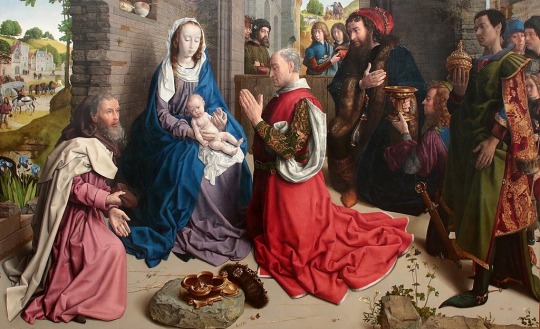
Hugo Van der Goes’ Monforte Altarpiece, c.1470
Toying with the idea of Jesus having a "Famous Daddy", and being what could be called a "nepo baby" of extreme influence, we decided the upon a photo reenactment incorporating a Easter eggs of pop culture along, including fashion magazines, lines of white substances, and with symbols that are seen as privilege's of a certain high standard like a contract handed to the newborn.
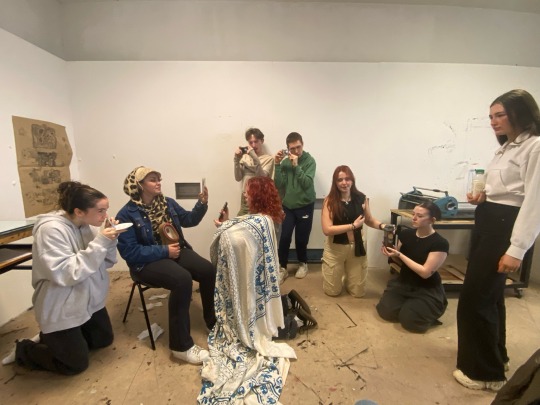
The first Draft, inside
We had decided the piece would take place outside in the smoking area. I was directing the piece so this photo was to help me get an idea of where people will be positioned before we committed to setting up outside.



The Final Pieces
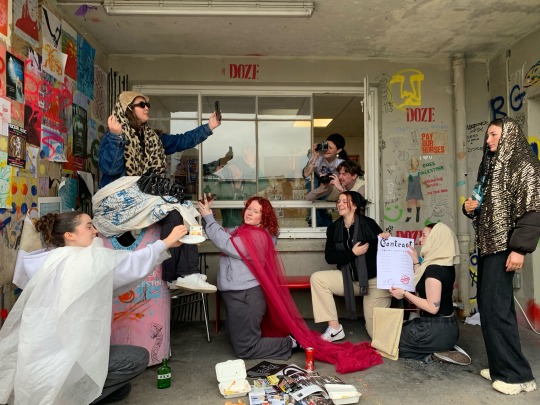
1 note
·
View note